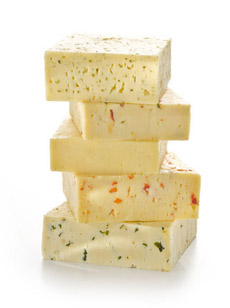
A tower of regular and flavored havartis. Photo courtesy Emmi Roth USA.
|
|
Americans love cheese: atop pizza, on burgers, in mac and cheese. But most of us don’t know that havarti, a Danish cow’s milk cheese, is a great melter as well as a table cheese.
The semisoft, rindless cheese with small eyes is popular as a table cheese and a sandwich cheese. Now, get to know it as a recipe cheese.
We actually know who created havarti: Hanne Nielsen, who operated an experimental farm called Havarthigaard, north of Copenhagen, in the latter half of the 19th century. She kept it close, though; havarti was not introduced commercially until around 1920.
With its buttery aroma and flavor, the cheese was a hit. As it ages, it becomes saltier and nutty, with a slightly crumbly texture.
Havarti pairs well with beer, Chardonnay, Sauvignon Blanc and light-bodied Pinot Noir.
If you like havarti, also try Danish tilsit, also known as tilsit havarti. It’s a more intensely flavorful version of havarti, but milder than German tilsit.
|
Like havarti, tilsit is a good melter, excellent on regular and grilled sandwiches, burgers, and delightful melted over potatoes and other vegetables.
We recommend that you avoid a product called cream havarti, which may sound tempting but isn’t. It’s made from ultrapasteurized milk to raise yields. The process produces more cheese, but alters the taste and texture.
FLAVORED HAVARTI
Havarti blends beautifully with other flavors. As a result, there’s a wealth of flavored havartis: basil, caraway, chive, coconut, cranberry, dill, garlic jalapeño and red pepper, among others.
Beyond the cheese plate, how should you serve havarti? For starters, use it instead of other cheeses in your favorite recipes.
|




